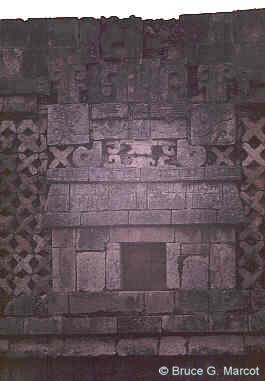

The rest of the image is adorned with serpentine snake images toward the top of the photo, and "X" patterns, perhaps also conjuring serpents, in the so-called Puuk style Mayan architecture.
It should be noted, too, that the name "Nunnary Quadrangle," like so many other site and building names in ancient Mayan cities, is merely the name given by early archeologists, not the true Mayan name. In most cases, we do not know the true Mayan names, nor the specific purposes of many structures.
This image of a modest Mayan hut also bears resemblance to full buildings at Uxmal, namely the building at the end of the huge Ball Court. It also bears resemblance to the stone faces that adorn the palaces and pyramids of the feathered serpent-god Quetzalcoatl at Teotihuacan, in south-central Mexico. The universal appearance of many of these images is striking, particularly in how they cut the grain across the meaning of various symbols, as well as the tremendous geographic extent over which they are found in Mesoamerica.
Here is a view of the Nunnary Quadrangle building at Uxmal. Under the tallest roof pillars are stone faces; in the center top (above the middle opening of the top 5 windows) is the Mayan house figure shown above.
It is rather striking, as well, that the entire Nunnary Quadrangle building design, as well as that of the imbedded stone faces, conjure the design of the face of the two-headed monster. There are also similarities with other Mayan structures, such as the Temple of the Seven Dolls at Dzilbilcaltum on the Yucatan, and even, recursively, the 8 stone faces found on that building as well! In the Mayan world, architecture and symbolism often collided.
Back to the Ancient America Page
Back to The Knowledge Plexus